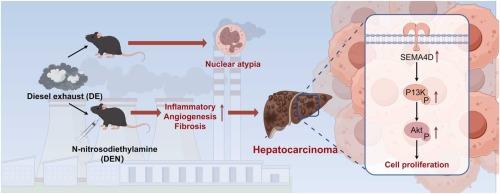柴油机尾气促进二乙基亚硝胺诱导小鼠肝癌的发生
IF 11.3
1区 环境科学与生态学
Q1 ENGINEERING, ENVIRONMENTAL
引用次数: 0
摘要
暴露在柴油废气中会增加患各种癌症的风险,包括肝癌。然而,驱动这种联系的潜在机制仍然没有得到充分的了解。在本研究中,我们采用二乙基亚硝胺(DEN)诱导的小鼠肝脏肿瘤模型,采用DE暴露系统进行19周的联合暴露(750 μg/m3)。我们的研究结果表明,长期暴露于DE可以激活癌症相关基因,并促进den诱导的肝脏肿瘤的形成。与DEN组相比,DEN + DEE组小鼠体重更低,肿瘤形成率更高,DNA损伤更严重。DE的促肿瘤作用可能与上调SEMA4D和激活PI3K/AKT信号通路有关。此外,DEE组的肝细胞表现出核异型性,这是癌变的一个特征。体外研究表明,暴露于柴油尾气颗粒(DEP)通过上调SEMA4D和激活PI3K/AKT信号通路,促进HepG2细胞和HUH7细胞的增殖。通过抑制SEMA4D或PI3K,这种作用减弱。本研究首次发现DE暴露促进den诱导的小鼠肝脏肿瘤的发展,其机制可能涉及SEMA4D/PI3K/AKT通路。这些发现为DE的肝毒性作用提供了新的见解,并强调了进一步研究其致癌潜力的必要性。本文章由计算机程序翻译,如有差异,请以英文原文为准。

Diesel Exhaust Promoted Diethylnitrosamine-Induced Hepatocarcinogenesis in Mice
Exposure to diesel exhaust (DE) has been linked to an increased risk of various cancers, including liver cancer. However, the underlying mechanisms driving this association remain insufficiently understood. In this study, we employed a diethylnitrosamine (DEN)-induced mouse liver tumor model and conducted a 19-week combined exposure (750 μg/m3) using a DE exposure system. Our results demonstrated that long-term DE exposure activates cancer-related genes and enhances the formation of DEN-induced liver tumors. Compared to the DEN group, mice in the DEN + DEE group exhibited lower body weight, higher tumor formation rates and more severe DNA damage. The tumor-promoting effect of DE may be associated with the upregulation of SEMA4D and the activation of the PI3K/AKT signaling pathway. Additionally, liver cells in the DEE group exhibited nuclear atypia, a characteristic feature of cancerous transformation. In vitro studies have revealed that exposure to diesel exhaust particles (DEP) promotes the proliferation of HepG2 cells and HUH7 cells by upregulating SEMA4D and activating the PI3K/AKT signaling pathway. This effect was attenuated by inhibiting either SEMA4D or PI3K. This study was the first to identify that DE exposure promotes the development of DEN-induced liver tumors in mice, with the mechanism potentially involving the SEMA4D/PI3K/AKT pathway. These findings provide novel insights into the hepatotoxic effects of DE and highlight the need for further investigation into its carcinogenic potential.
求助全文
通过发布文献求助,成功后即可免费获取论文全文。
去求助
来源期刊

Journal of Hazardous Materials
工程技术-工程:环境
CiteScore
25.40
自引率
5.90%
发文量
3059
审稿时长
58 days
期刊介绍:
The Journal of Hazardous Materials serves as a global platform for promoting cutting-edge research in the field of Environmental Science and Engineering. Our publication features a wide range of articles, including full-length research papers, review articles, and perspectives, with the aim of enhancing our understanding of the dangers and risks associated with various materials concerning public health and the environment. It is important to note that the term "environmental contaminants" refers specifically to substances that pose hazardous effects through contamination, while excluding those that do not have such impacts on the environment or human health. Moreover, we emphasize the distinction between wastes and hazardous materials in order to provide further clarity on the scope of the journal. We have a keen interest in exploring specific compounds and microbial agents that have adverse effects on the environment.
 求助内容:
求助内容: 应助结果提醒方式:
应助结果提醒方式:


